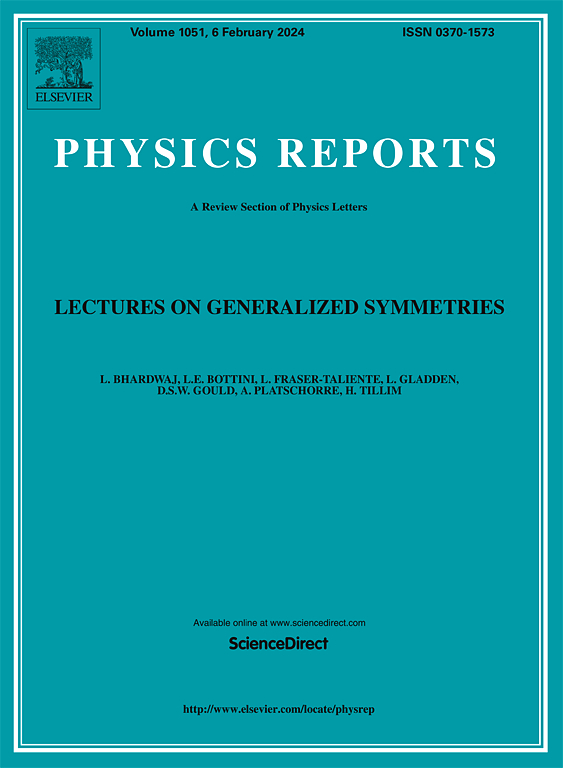Three ways to decipher the nature of exotic hadrons: Multiplets, three-body hadronic molecules, and correlation functions
IF 29.5
1区 物理与天体物理
Q1 PHYSICS, MULTIDISCIPLINARY
引用次数: 0
Abstract
In the past two decades, a plethora of hadronic states beyond the conventional quark model of mesons and baryons have been observed experimentally, which motivated extensive studies to understand their nature and the non-perturbative strong interaction. Since most of these exotic states are located near the mass thresholds of a pair of conventional hadrons, the prevailing picture is that they are primarily hadronic molecules. In principle, one can verify the molecular nature of these states by thoroughly comparing their masses, decay widths, and production rates in a particular picture with experimental data. However, this is difficult or impossible. First, quantum mechanics allows for mixing configurations permitted by symmetries and quantum numbers. Second, data are relatively scarce because of their small production rates and the many difficulties in the experimental measurements. As a result, other alternatives need to be explored. This review summarizes three such approaches that can help disentangle the nature of the many exotic hadrons discovered.
In the first approach, based on the molecular interpretations for some exotic states, we study the likely existence of multiplets of hadronic molecules related by various symmetries, such as isospin symmetry, SU(3)-flavor symmetry, heavy quark spin/flavor symmetry, and heavy antiquark diquark symmetry, which are known to be approximately satisfied and can be employed to relate the underlying hadron–hadron interactions responsible for the formation of hadronic molecules. The masses of these multiplets of hadronic molecules can then be obtained by solving the Lippmann–Schwinger equation. Their decay and production patterns are also related. As a result, experimental discoveries of such multiplets and confirmations of the predicted patterns will be invaluable to understanding the nature of these hadronic molecular states.
In the second approach, starting from some hadronic molecular candidates, one can derive the underlying hadron–hadron interactions. With these interactions, one can study related three-body systems and check whether three-body bound states/resonances exist. The existence of such three-body molecules can directly verify the molecular nature of exotic hadrons of interest.
In the third approach, one can turn to the femtoscopy technique to derive the hadron–hadron interactions, hence inaccessible. This technique provided an unprecedented opportunity to understand the interactions between unstable hadrons. Although the past focus was mainly on the light quark sector, we have seen increasing theoretical activities in the heavy quark sector in recent years. We review relevant studies and point out future directions where more effort is needed.
Finally, to provide valuable information for present and future experiments, the decay widths and production rates of these multiplets and three-body hadronic molecules are estimated and discussed using the effective Lagrangian approaches.
破译奇异强子性质的三种方法:多重态、三体强子分子和相关函数
在过去的二十年中,大量的强子态超出了传统的qqq介子和qqq重子的夸克模型,这激发了广泛的研究,以了解它们的性质和非微扰强相互作用。由于这些奇异态大多位于一对传统强子的质量阈值附近,因此普遍认为它们主要是强子分子。原则上,人们可以通过彻底比较它们的质量、衰变宽度和特定图像中的生成速率与实验数据来验证这些状态的分子性质。然而,这是困难的或不可能的。首先,量子力学允许对称和量子数所允许的混合构型。其次,由于其产量小,实验测量困难重重,数据相对较少。因此,需要探索其他替代方案。这篇综述总结了三种这样的方法,可以帮助解开许多发现的外来强子的性质。在第一种方法中,基于对一些奇异态的分子解释,我们研究了与各种对称性相关的强子分子多重重态的可能存在性,如同位旋对称、SU(3)-flavor对称、重夸克自旋/flavor对称和重反夸克二夸克对称,这些对称性已知是近似满足的,可以用来联系导致强子分子形成的潜在强子-强子相互作用。这些重子分子的质量可以通过求解李普曼-施温格方程得到。它们的衰变和生产模式也有关系。因此,这种多重态的实验发现和预测模式的确认对于理解这些强子分子状态的本质将是无价的。在第二种方法中,从一些强子候选分子开始,人们可以推导出潜在的强子-强子相互作用。通过这些相互作用,可以研究相关的三体系统,并检查是否存在三体束缚态/共振。这种三体分子的存在可以直接验证所研究的外来强子的分子性质。在第三种方法中,人们可以转向飞镜技术来推导强子-强子相互作用,因此无法实现。这项技术为了解不稳定强子之间的相互作用提供了前所未有的机会。虽然过去的焦点主要集中在轻夸克领域,但近年来我们看到在重夸克领域的理论活动越来越多。我们回顾了相关研究,并指出了未来需要进一步努力的方向。最后,为了给现在和将来的实验提供有价值的信息,我们用有效的拉格朗日方法估计和讨论了这些多重体和三体强子分子的衰变宽度和产生速率。
本文章由计算机程序翻译,如有差异,请以英文原文为准。
求助全文
约1分钟内获得全文
求助全文
来源期刊

Physics Reports
物理-物理:综合
CiteScore
56.10
自引率
0.70%
发文量
102
审稿时长
9.1 weeks
期刊介绍:
Physics Reports keeps the active physicist up-to-date on developments in a wide range of topics by publishing timely reviews which are more extensive than just literature surveys but normally less than a full monograph. Each report deals with one specific subject and is generally published in a separate volume. These reviews are specialist in nature but contain enough introductory material to make the main points intelligible to a non-specialist. The reader will not only be able to distinguish important developments and trends in physics but will also find a sufficient number of references to the original literature.
 求助内容:
求助内容: 应助结果提醒方式:
应助结果提醒方式:


